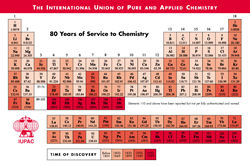


Investigating this further, Döbereiner found that other elements followed this pattern, and so he began to group elements into “triads.” Other chemists built on Döbereiner’s work to observe that elements with similar atomic masses also exhibited similar properties. In the early 19th century, a scientist named Johann Döbereiner (1780–1849) noticed that strontium’s atomic mass fell exactly between the atomic masses of calcium and barium. © The Regents of the University of California, Lawrence Berkeley National Laboratory, 2010. Dmitri Mendeleev created the Periodic Table That We Still Use Today Americans won the rights to name element 104 after Ernest Rutherford (rutherfordium), and the Russians won the rights to name element 105 (dubnium) after Dubna, the town in Russia where the element was discovered.įigure 4-2. Only after the end of the Cold War, in 1997, did IUPAC settle the dispute between the Americans and Soviets. The International Union of Pure and Applied Chemistry, or IUPAC, the global organization charged with establishing standard practices for chemists, is responsible for handing out naming rights to labs in honor of discovering the element. In the 1960s, research groups in the Soviet Union and the United States simultaneously claimed the discovery of elements 104 and 105. The naming of elements turned out to be one of the last battlegrounds of the Cold War.
#PERIODIC TABLE CHEMISTRY REVIEW HOW TO#
The periodic table contains a wealth of information, once we know how to interpret it. The discoverers of these elements named them in honor of home countries or to commemorate other influential scientists. Some elements have countries in their names (francium, polonium, and germanium), while others bear the names of notable scientists (einsteinium, nobelium, and curium). In addition to chemical properties, the periodic table reveals the cultural history of each element. We also will examine how these patterns allow us to predict the formation of compounds. In this unit, we will discuss some of those patterns, including electron configuration, size, and reactivity. In addition to the atomic number, there are many patterns within the periodic table. In fact, if the number of protons was to change, the atom’s identity would change. We can organize the periodic table this way because all atoms of a specific element have the same number of protons. The table is organized by atomic number, which is the number of protons in the nucleus.


 0 kommentar(er)
0 kommentar(er)
